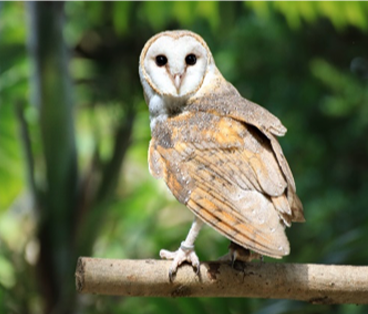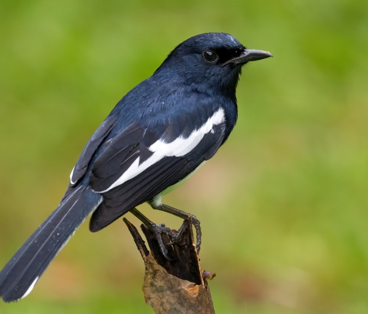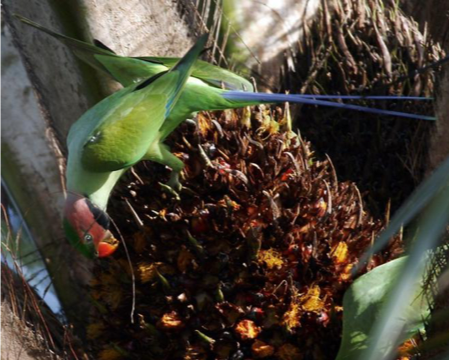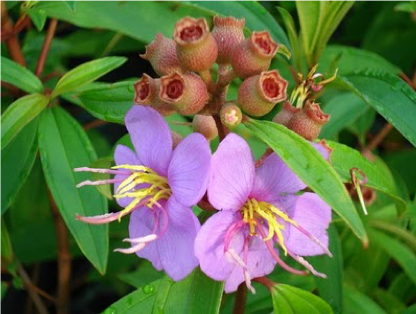Birds play an important role in controlling pests in oil palm plantations. The most useful bird is the barn owl (Tyto alba) which is known for its capability to control rat population. There are other less popular bird species such as Magpie Robin (Copsychus saularis) and the Yellow-vented Bulbul (Pycnonotus goiavier). These two species prey on insects and therefore play an important role in insect pest control.

Barn Owl

Magpie Robin

Yellow Vented Bulbul

Oil palm plantation owners are encouraged to have more bird species in their estates. By having these birds in their plantations, the usage of harmful pesticides can be reduced; thus reducing cost and harmful impact on the environment. However, bird species such as the Long-tailed Parakeet (Psittacula longicauda) that feeds on oil palm fruitlets can cause some losses. Nevertheless, the damage caused by this bird is small compared to those caused by rats and insect pests.
Long-tailed Parakeet feed on oil palm fruitlets. Photo Credit: Wikipedia
Planters are also encouraged to allow shrubs like Indian Rhododenron (Melastoma malabathricum) to grow naturally in their estates. This shrub produces berries that feed the birds and this will encourage them to nest in oil palm plantations.
Indian Rhododendron (flower and berries). Photo credit: Temasek Junior College

There are two major threats to birds in oil palm plantations. The first is from the use of chemical pesticides. Salim et al., (2016) found that within 30 months, a population of 40 barn owls was reduced to two. Many were found dead with bleeding from the nostrils, which is a characteristic of anti-coagulant rodenticide poisoning. He also suggested that rodenticides do not only kill owls but can also induce compromised or stunted growth.
The other threat the birds are facing is from hunting activities. Beautiful melodious species such as the Long-tailed Parakeet (Psittacula longicauda), Straw-headed Bulbul (Pycnonotus zeylanicus) and White-rumped Shama (Copsychus malabaricus) are hunted for pets. These birds provide important ecosystem services such as pest control, pollinators and seed dispersal. These birds are also protected under the national law and hunting them is illegal.

In conclusion, birds play important roles in keeping the ecosystem in balance, not just in natural forest habitat, but also in oil palm plantations. Having birds in the oil palm plantations will be beneficial in controlling pests. The birds are able to reduce dependency on chemical pesticides thus reducing costs and minimizing negative impact on the environment.
References:
- Malaysian Palm Oil Council Europe (2020). The Malaysian Palm Oil Industry In 2020. An Interview With Dr. Kalyana Sundram. [online] Available at: <https://mpoc.eu/the-malaysian-palm-oil-industry-in-2020-an-interview-with-dr-kalyana-sundram/> [Accessed 1 September 2020]
- Malaysian Palm Oil Council (2019). Malaysian Palm Oil Enriching Lives. MPOC
- Kross, S.M., Ingram, K.P., Long, R.F. and Niles, M.T., (2018). Farmer perceptions and behaviors related to wildlife and on‐farm conservation actions. Conservation Letters, 11(1), e12364.
- Pejchar, L., Clough, Y., Ekroos, J., Nicholas, K.A., Olsson, O.L.A., Ram, D., Tschumi, M. and Smith, H.G., (2018). Net effects of birds in agroecosystems. BioScience, 68(11), pp.896-904.
- Salim, H., Noor, H.M., Tajudin, R., Hamid, N.H., Omar, D., Kasim, A. and Abidin, M.R.Z., (2016). Effects of rodenticide on growth of nestling barn owl, Tyto alba javanica in oil palm plantations. [online] Available at <http://jopr.mpob.gov.my/wp-content/uploads/2016/03/joprv28n1 hasber.pdf > accessed on 1 September 2020
- Sekercioglu, Ç.H., Wenny, D.G. and Whelan, C.J. eds., (2016). Why birds matter: avian ecological function and ecosystem services. University of Chicago Press.
- Ministry of Natural Resources and Environment of Malaysia (2015). 5th National Report to Convention on Biological Diversity. pp 14-15 [online] Available at: < https://www.mybis.gov.my/pb/172> Accessed 1 September 2020
- Amit, B., Tuen, A.A., Haron, K. and Harun, M.H., (2014). Diversity of Bird Species in the Oil Palm Plantation on Peat. Oil Palm Bulletin, 69, 21-26.
- Karp, D.S., Mendenhall, C.D., Sandí, R.F., Chaumont, N., Ehrlich, P.R., Hadly, E.A. and Daily, G.C., (2013). Forest bolsters bird abundance, pest control and coffee yield. Ecology letters, 16(11), 1339-1347.
- Azhar, B., Lindenmayer, D. B., Wood, J., Fischer, J., Manning, A., Mcelhinny, C., & Zakaria, M. (2013). The influence of agricultural system, stand structural complexity and landscape context on foraging birds in oil palm landscapes. Ibis, 155(2), pp. 297-312.
- Jambari, A., Azhar, B., Ibrahim, N.L., Jamian, S., Hussin, A., Puan, C.L., Noor, H.M., Yusof, E. and Zakaria, M., (2012). Avian biodiversity and conservation in Malaysian oil palm production areas. Journal of Oil Palm Research, 24, 1277-1286.
- Mäntylä, E., Klemola, T. and Laaksonen, T., (2011). Birds help plants: a meta-analysis of top-down trophic cascades caused by avian predators. Oecologia, 165(1), 143-151.
